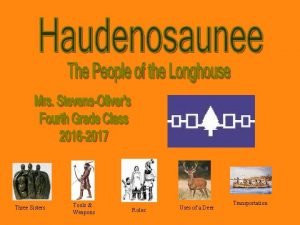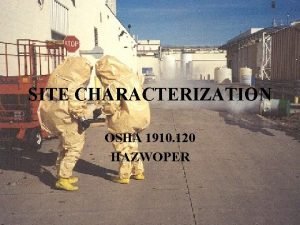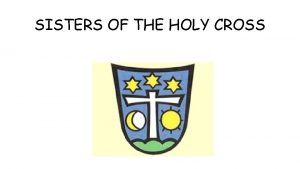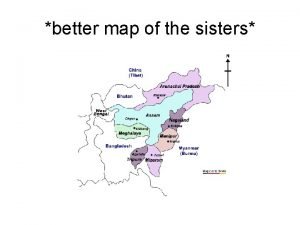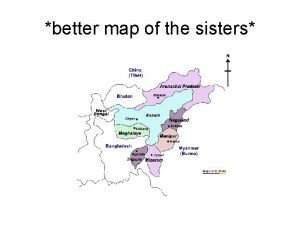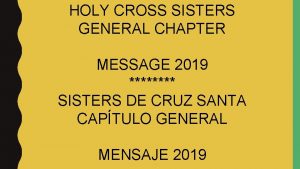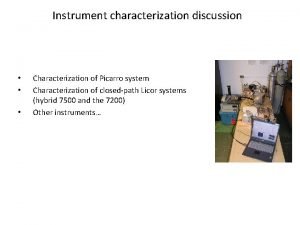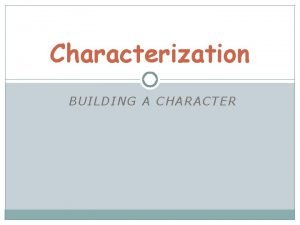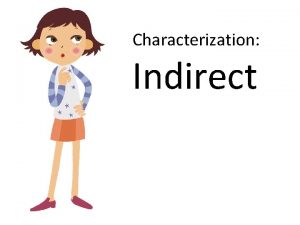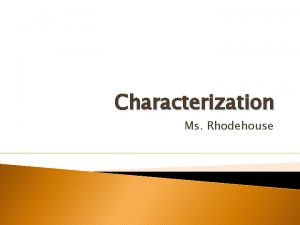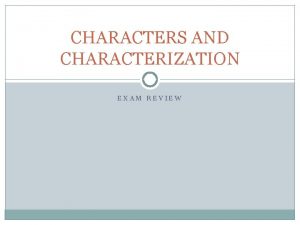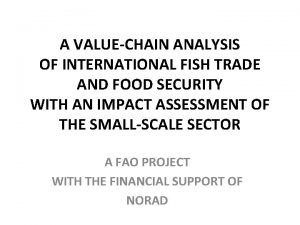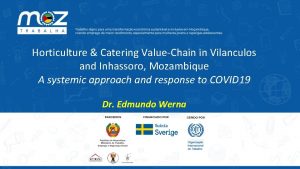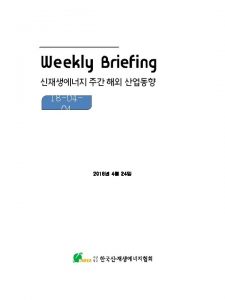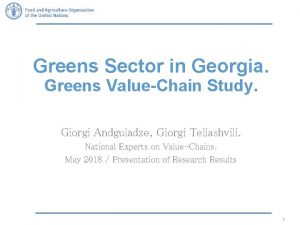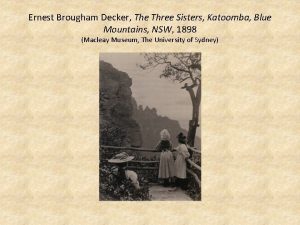The Three Sisters Three Sisters valuechain characterization of





























- Slides: 29

“The Three Sisters“ Three Sisters value-chain: characterization of attributes and functionalities of aboriginal corn, squash and bean varieties, preservation of genetic material and prefeasibility of new culture models Science & Technology Branch Project # 1205

Participants • Sébastien Villeneuve, AAFC, St-Hyacinthe Research & Development Centre, St-Hyacinthe, QC • Stéphane Gariépy, AAFC, Knowledge and Technology Transfer Office, Quebec City, QC • Other major participants: Martin Mondor, St-Hyacinthe R&D Centre Michel Gros-Louis, St-Hyacinthe R&D Centre - KTT-Quebec Marie Thérèse Charles, St-Jean-sur-Richelieu R&D Centre Judith Frégeau-Reed, Ottawa R&D Centre Carl Bélec, St-Jean-sur-Richelieu R&D Centre Axel Diederichsen, Curator, Research Scientist, Plant Gene Resources of Canada – Doctoral student: Thomas Burelli, KTT-Quebec – – –

Indigenous Participants • Vincent Lévesque, Les Produits Autochtones Terre de l‘Aigle, Wendake, QC, ASIFP president • Charly Jacob, indigenous corn producer and seed keeper, Kanahwake, QC, ASIFP administrator • Julie Landry, Wôlinak, QC, ASIFP administrator. ASIFP : Agricultural Society for indigenous food Products

The Three Sisters • Among Native Americans, the group of plants consisting of maize, squash and beans is called the “Three Sisters. ” • Agronomically, interplanting these crops improves disease resistance, increases productivity and requires less fertilization. • The Three Sisters are still grown together today in some community and family gardens. • Some ancestral varieties are available on the market to gardeners: Iroquois white corn, Mohawk red corn, Crookneck squash, Algonquin pumpkins, Early Mohawk beans, Hopi Black beans…


The Three sisters and AAFC • Scientists at AAFC are developing processes to enhance agri-food production through, for example: – maize nixtamalization with hardwood ash, from which the processed product is used in making Native American breads and soups; – the extraction of functional components in pumpkins; – the processing of beans into bioproducts for the agrifood industry. • They also have expertise in horticulture, crop genetic, etc.

What about a project where we would approach Indigenous agriculture in an integrated manner inspired from the Three Sisters companion technique?

Indigenous agri-food value chain

AAFC Project • Since 2015, Agriculture and Agri-Food Canada has been conducting a Three Sisters project with the participation of Indigenous collaborators to: – increase awareness of and preserve ancestral varieties of corn, beans and squash; – explore methods of growing the Three Sisters (raised beds, intercrops, etc. ); – work together to produce new ingredients and new products; – support new Indigenous agricultural and agrifood activities.

Some questions • Are there ancestral plant genetic resources that could be used in the project? • How should we proceed with the holders? • Will the varieties caracteristics be interesting for value-added products? • Are there varieties that could be endangered and what could be contribute to protect them? • What will be the yield of the Three sisters and which pattern of crop should be used?

AAFC Project • The main focus is to study the characteristics of the ancestral lineages of maize, squash (including pumpkins) and beans, and of derived ingredients in order to develop value added products with Indigenous stakeholders. • The bioactive compound content, which is beneficial to human health, will be evaluated as well as the functionality and attributes of derived ingredients.

The Project • A feasibility study to develop reviewed crop models involving the Three Sisters that are sustainable, practical and culturally acceptable will be carried out. • The necessary knowledge will come from scientific and historical literature, interviews and conversations with Indigenous producers and gardeners, and workshops to identify farming models. • With respect to knowledge transfer, Indigenous partners are involved in the project to ensure a good balance between proposed practices and needs.

The Project • Seeds could come from various communities, and agreements will have to be established to ensure the protection of Indigenous rights with regard to genetic material. • The data gathered on ancestral lineages and their genetic diversity could help identify ways to protect and preserve the genetic material of these lineages; to this end and on a collaboration basis with Indigenous stakeholders, samples could be kept in a gene bank.

Current project status • Summer 2015 : Cultivated parcels of ancestral varieties bought on the market were implemented: – Iroquois white corn, Mohawk red corn; – Crookneck squash, Algonquin pumpkins; – Early Mohawk beans, Hopi Black beans… • Fall-winter 2015 : – Development of analysis protocols – Fresh/coarse product caracterisation – Ingredients production and analysis

Current project status Winter-Spring 2015 -2016 : • Development relating to research frameworks involving researchers and Indigenous communities. • Organization of this workshop in collaboration with Université Laval, PROCINORTE, IICA, ASIFP. • Excursions have been planned and achieved to encounter seed keepers in communities: Akwasasne, Kahnawake, Tyendenaga, Six Nations of the Grand River.

Michel Gros-Louis’ Journey

Merci! Tiawenhk! Questions?


Impacts of the project • In the medium term and long term, the project involving the characterization and production of the Three Sisters should have positive social, cultural and economic impacts on First Nations. • More will be known about the indigenous varieties, which will be preserved for Native Americans and future generations. Findings from the horticultural and characterization components will help determine the need for sustainable crop models involving the Three Sisters, carry out a prefeasibility study and guide any future development. • In time, we could see an improvement in the use of agricultural land on Indian reserves and their surroundings, and local, community and private agricultural and agri-food businesses could be created. • Finally, some acquired knowledge could result in more innovative crop systems that would be not only Aboriginal, but also organic and conventional.



Traditional nixtamalisation process (in Mexico) A tank contains maize in a warm lime solution.

Project background 1. 2. Aboriginal Agriculture Initiative (2010 -2014) FRDC-KTTQ collaboration: Aboriginal Agriculture and Agri. Food in Quebec: Status Report and Considerations for Developing a Knowledge and Technology Transfer Strategy (Gros-Louis & Gariépy, 2013) 3. Strategic Planning for KTT in Support to of Aboriginal AAF in the Quebec Region (2013) 4. Projects: 2 finished; 1 ongoing • • • A number of First Nations agricultural producers in Quebec. A limited number of production industries, including maple syrup, berry harvesting and processing, and marine fisheries. Some ten thousand hectares of arable land available on reserves. Interest from business and community aboriginal people Strategy’s approval yet to come To develop the production-processingpreservation chain for Aboriginal products 23

Project background Resulting initiatives • The Food Research and Development Centre (FRDC) in Saint-Hyacinthe – 2 finished projects with Aboriginal entrepreneurs – 2 potential projects defined DT project: productionprocessing chain for the Three Sisters polyculture system (corn, squash & beans) • Labrador Tea extracts for various uses: iced-tea, food products (Terre de l’aigle enr. , Wendake) • Corn nixtamalization process based on ancestral Mohawk methods to produce hominy corn (C. Jacob, Kahnawake) • Pumpkin valorization (Mohawk) • Smoked sturgeon cheese enriched with seal oil (Inuit – Cris – Abénakis) 24


Workshop Conservation and Development of Ancestral/Indigenous Plant Genetic Resources: Challenges, Tools and Perspectives Sharing the Canadian, Mexican and American Experiences • To share among participants experiences and practices with regard to ancestral/indigenous plant genetic resources, to promote the potential benefits of sharing scientific and traditional knowledge, and to build trust for achieving the most valuable benefits possible for Indigenous communities while respecting their rights and concerns. • A workshop was held on May 10 -11, 2016 which aimed to discuss the conditions for success in collaboration between Indigenous and no Indigenous stakeholders to work towards more. their experience and practices in ex situ conservation and utilization strategies for crop plant diversity

Avancement du projet • Été 2015 : Mise en place de parcelles de production de variétés ancestrales disponibles sur le marché – maïs Iroquois white, maïs Mohawk Red; – courge Crookneck, citrouille Agonquin; – haricot Early Mohawk, haricot nain Hopi Black… • Automne-hiver 2015 : – Mise au point des techniques d’analyse – Caractérisation des produits bruts – Production d’ingrédients et caractérisation

Avancement du projet Hiver-printemps 2015 -2016 : • Organisation et réalisation d’expéditions pour rencontrer des gardiens des semences dans les communautés de : Akwasasne, Kahnawake, Tyendenaga, Six Nations of the Grand River. Obtention d’une dizaine de variétés de maïs et de haricots. • Développement relatif aux ententes de collaboration entre scientifiques et Autochtones. • Organisation d’un atelier sur la conservation des semences en collaboration avec l’Université Laval, PROCINORTE, IICA, ASIFP.

Cultivated parcels in St-Jean-sur. Richelieu
 Indirect characterization meaning
Indirect characterization meaning What is direct characterization
What is direct characterization Iroquois tools and weapons
Iroquois tools and weapons Site characterization hazwoper
Site characterization hazwoper Sự nuôi và dạy con của hươu
Sự nuôi và dạy con của hươu Thế nào là mạng điện lắp đặt kiểu nổi
Thế nào là mạng điện lắp đặt kiểu nổi Các châu lục và đại dương trên thế giới
Các châu lục và đại dương trên thế giới Các loại đột biến cấu trúc nhiễm sắc thể
Các loại đột biến cấu trúc nhiễm sắc thể Thế nào là sự mỏi cơ
Thế nào là sự mỏi cơ Bổ thể
Bổ thể độ dài liên kết
độ dài liên kết Thiếu nhi thế giới liên hoan
Thiếu nhi thế giới liên hoan Chúa sống lại
Chúa sống lại điện thế nghỉ
điện thế nghỉ Vẽ hình chiếu vuông góc của vật thể sau
Vẽ hình chiếu vuông góc của vật thể sau Một số thể thơ truyền thống
Một số thể thơ truyền thống Trời xanh đây là của chúng ta thể thơ
Trời xanh đây là của chúng ta thể thơ Hệ hô hấp
Hệ hô hấp Công thức tính thế năng
Công thức tính thế năng Thế nào là số nguyên tố
Thế nào là số nguyên tố đặc điểm cơ thể của người tối cổ
đặc điểm cơ thể của người tối cổ Tỉ lệ cơ thể trẻ em
Tỉ lệ cơ thể trẻ em Các châu lục và đại dương trên thế giới
Các châu lục và đại dương trên thế giới ưu thế lai là gì
ưu thế lai là gì Các môn thể thao bắt đầu bằng tiếng nhảy
Các môn thể thao bắt đầu bằng tiếng nhảy Tư thế ngồi viết
Tư thế ngồi viết Hình ảnh bộ gõ cơ thể búng tay
Hình ảnh bộ gõ cơ thể búng tay Cái miệng xinh xinh thế chỉ nói điều hay thôi
Cái miệng xinh xinh thế chỉ nói điều hay thôi Cách giải mật thư tọa độ
Cách giải mật thư tọa độ Từ ngữ thể hiện lòng nhân hậu
Từ ngữ thể hiện lòng nhân hậu


